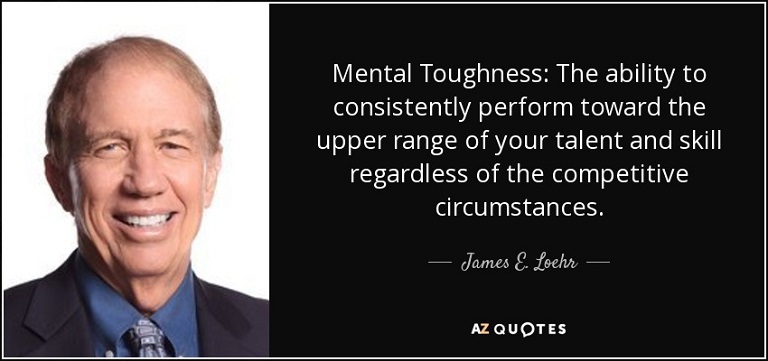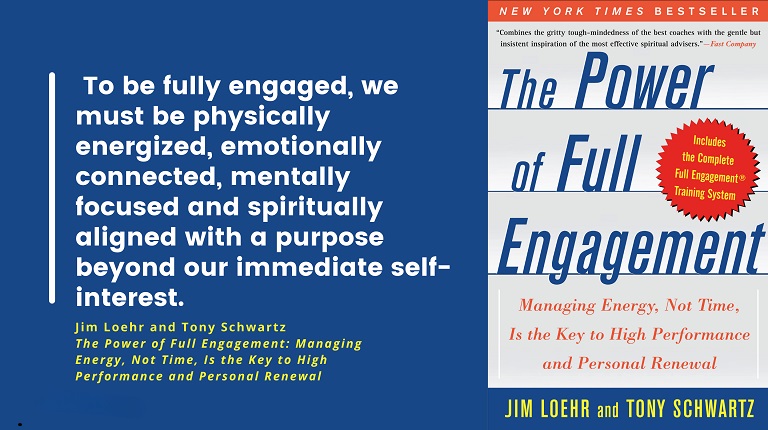Summary of the book The Power of Full Engagement – Unlocking the Secret to Success
In today’s fast-paced and demanding world, many individuals find themselves constantly chasing after more time, believing it to be the ultimate key to productivity and success. However, renowned authors Jim Loehr and Tony Schwartz challenge this conventional notion in their groundbreaking book “The Power of Full Engagement: Managing Energy, Not Time, Is the Key to High Performance and Personal Renewal”. Drawing from extensive research in psychology and performance science, Loehr and Schwartz argue that managing our energy levels is far more crucial than simply managing our time if we truly aim for sustainable high performance.
Loehr and Schwartz’s thesis centers around the concept of energy management as the foundation for optimizing various aspects of life – from work performance to personal well-being.
The Power of Full Engagement: Overview
The Power of Full Engagement is a groundbreaking book that challenges the traditional notion that time management is the key to high performance. Instead, authors Jim Loehr and Tony Schwartz argue that managing energy is actually the secret to achieving peak performance and personal renewal. Drawing on their extensive research and experience working with top athletes, executives, and other high-achievers, Loehr and Schwartz outline a comprehensive approach to managing one’s energy in order to maximize productivity, engagement, and overall well-being.
The book emphasizes the importance of balancing periods of intense effort with intentional periods of rest and recovery. It introduces the concept of pulse, which refers to the rhythmic oscillation between expending energy during focused work or physical activity, followed by strategic periods of renewal such as relaxation or deep sleep. By recognizing these natural rhythms in our own lives and learning how to optimize our energy levels accordingly, we can achieve greater efficiency, effectiveness, creativity, and resilience.
Loehr and Schwartz also highlight the critical role that physical fitness plays in overall energy management. They delve into various techniques for improving physical vitality through proper nutrition, exercise routines tailored to individual needs, adequate sleep habits, stress reduction strategies like mindfulness meditation or breathing exercises. Ultimately,The Power of Full Engagement offers practical insights into how individuals can proactively manage their energy levels rather than simply reacting passively to external demands – leading not only to enhanced performance but also personal fulfillment.
The Importance of Managing Energy, Not Time
In today’s fast-paced world, time management has become a buzzword for productivity. However, according to the book The Power of Full Engagement, managing energy is actually more important than managing time when it comes to achieving high performance and personal renewal. The authors argue that time is a finite resource, whereas energy can be renewed and expanded. They emphasize that individuals should focus on managing their energy levels throughout the day in order to maximize productivity and overall well-being.
The book suggests that there are four key sources of energy: physical, emotional, mental, and spiritual. Each source plays a vital role in our ability to perform at our best. For example, physical energy refers to the level of stamina and vitality we have throughout the day. By taking care of our physical health through exercise, nutrition, and adequate rest, we can increase our capacity for sustained performance.
Emotional energy relates to how well we manage our emotions and maintain positive relationships with others. Mental energy involves the ability to focus, make decisions effectively, and think creatively. Lastly, spiritual energy encompasses having a sense of purpose and aligning our values with our actions. The book argues that by nurturing these four sources of energy rather than simply trying to manage time better, individuals can achieve higher levels of success while also experiencing greater fulfillment in their lives.
The Four Energy Quadrants: Physical, Emotional, Mental, and Spiritual
In their book The Power of Full Engagement, Jim Loehr and Tony Schwartz discuss the concept of energy management as a key aspect of personal growth and high performance. They introduce the idea of four energy quadrants: physical, emotional, mental, and spiritual.
The physical quadrant focuses on optimizing our physical well-being and vitality through practices such as exercise, nutrition, sleep, and relaxation. It emphasizes the importance of taking care of our bodies to increase energy levels and overall resilience.
The emotional quadrant highlights the significance of managing our emotions effectively for better performance. It involves understanding and expressing emotions in a healthy way while also cultivating positive relationships and social support networks.
The mental quadrant explores how we can enhance our cognitive abilities by cultivating focus, concentration, creativity, problem-solving skills, and continuous learning. It emphasizes the need to engage in activities that challenge us intellectually to stimulate growth.
Lastly, the spiritual quadrant delves into finding meaning and purpose in life beyond material pursuits. It involves connecting with values that are important to us personally or engaging in practices such as meditation or mindfulness to cultivate inner peace and harmony.
Overall, understanding these four energy quadrants allows individuals to holistically manage their energy levels across different aspects of life for optimal performance and personal growth.
Strategies for Managing Physical Energy
One strategy for managing physical energy is to prioritize rest and recovery. In their book The Power of Full Engagement, Loehr and Schwartz argue that the key to high performance is not constantly pushing yourself to the limit, but rather finding a balance between intense effort and adequate rest. They emphasize the importance of taking regular breaks throughout the day, as well as getting enough sleep each night. By prioritizing rest and recovery, individuals can recharge their physical energy reserves and avoid burnout.
Another strategy for managing physical energy is to incorporate movement into your daily routine. Loehr and Schwartz highlight the benefits of regular exercise in boosting physical energy levels. They suggest finding an activity that you enjoy and making it a non-negotiable part of your schedule. Whether it’s going for a walk during lunch break or hitting the gym after work, incorporating movement into your day can help increase stamina, improve focus, and enhance overall physical well-being. Additionally, they recommend taking short movement breaks throughout the day to combat sedentary behavior and keep energy levels up.
Strategies for Managing Emotional Energy
One strategy for managing emotional energy is to practice mindfulness and self-awareness. This involves paying attention to one’s emotions and thoughts without judgment, and being aware of how they are affecting one’s energy levels. By practicing mindfulness, individuals can learn to identify when their emotional energy is low or depleted, and take steps to replenish it. This may involve engaging in activities that bring joy or relaxation, such as spending time with loved ones, pursuing hobbies, or practicing self-care.
Another strategy for managing emotional energy is to set boundaries and prioritize self-care. It is important for individuals to recognize their own limits and not overextend themselves emotionally. This means learning to say no when necessary, setting clear boundaries with others, and prioritizing activities that promote personal well-being. Taking care of one’s physical health through regular exercise, proper nutrition, and adequate sleep can also have a significant impact on emotional energy levels. Additionally, engaging in activities that promote mental well-being such as therapy or meditation can help individuals better manage their emotional energy.

Strategies for Managing Mental Energy
In their book The Power of Full Engagement, Jim Loehr and Tony Schwartz emphasize the importance of managing mental energy for achieving high performance and personal renewal. They argue that time management alone is not enough to sustain peak performance, as it fails to address the fundamental issue of energy management. The authors present various strategies for effectively managing mental energy, such as establishing rituals and routines to optimize productivity, implementing regular breaks and recovery periods to avoid burnout, prioritizing activities that align with personal values and goals, practicing mindfulness and meditation techniques to enhance focus and reduce stress, and cultivating positive emotions through gratitude practices.
By implementing these strategies, individuals can enhance their ability to sustain high levels of mental energy throughout the day. The authors also highlight the significance of taking care of one’s physical health through proper nutrition, exercise, and sleep in order to support optimal mental energy levels. Ultimately, they argue that by managing mental energy instead of solely focusing on time management or external factors, individuals can achieve a greater sense of fulfillment in both their professional and personal lives.
Strategies for Managing Spiritual Energy
One strategy for managing spiritual energy is to incorporate regular spiritual practices into daily life. This can include things like meditation, prayer, or engaging in activities that bring a sense of peace and connection with something greater than oneself. By carving out time each day for these practices, individuals can replenish their spiritual energy and maintain a sense of balance and fulfillment.
Another strategy is to surround oneself with positive influences and supportive communities. Being around like-minded individuals who share similar spiritual beliefs can provide a source of inspiration and encouragement. Additionally, seeking out mentors or teachers who can guide one’s spiritual growth can be beneficial in managing spiritual energy. These relationships can offer guidance, wisdom, and support on the journey towards personal renewal and high performance in all aspects of life.
The strategies for managing spiritual energy involve carving out time for regular spiritual practices and surrounding oneself with positive influences that nourish the soul. By prioritizing these aspects of life, individuals can tap into their inner strength and find renewed purpose and motivation in their personal journey towards self-discovery and growth.
Conclusion: Applying the Principles of Full Engagement
In conclusion, applying the principles of full engagement can lead to a significant improvement in both personal and professional life. By managing energy instead of time, individuals can tap into their full potential and achieve high performance. This approach emphasizes the importance of balancing physical, emotional, mental, and spiritual energy to optimize productivity and overall well-being.
One key principle discussed in the book is the idea of oscillation between periods of intense focus and rest. This concept aligns with our natural rhythms as human beings. It suggests that by taking regular breaks to recharge and refuel our energy reserves, we can sustain higher levels of engagement for longer periods. This not only enhances productivity but also prevents burnout and promotes personal renewal.
Moreover, the authors emphasize the significance of aligning actions with values and purpose. When individuals are clear about their core values and motivated by a sense of purpose, they experience a deeper level of engagement in their activities. They become more resilient in facing challenges because they are driven by something greater than themselves. Applying this principle allows individuals to find meaning in their work or daily routines, leading to a more fulfilling and satisfying life overall.
Adopting the principles outlined in The Power of Full Engagement can revolutionize how we approach our lives on a day-to-day basis. By prioritizing energy management over time management, embracing oscillation between activity and rest, along with aligning actions with values and purpose – we can unlock our true potential for high performance while maintaining personal well-being.












